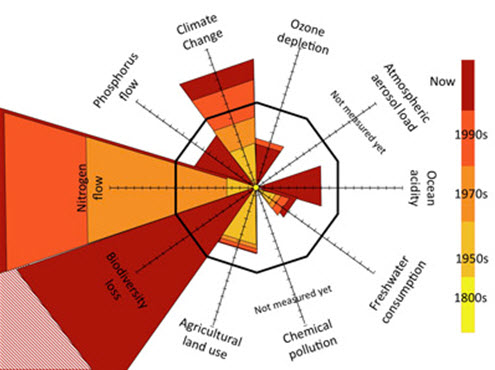The Holocene is the geological era that started 12 000 years ago. This is an exceptional period for human prosperity. It is in this environment that agriculture and complex societies developed themselves.
The Holocene is the geological era that started 12 000 years ago. This is an exceptional period for human prosperity. It is in this environment that agriculture and complex societies developed themselves. However, since 1950 things have changed: The action and impact of human activities. For the first time, the characteristics of the geological era can be directly associated to man. What some call the anthropocene era, a planet that has been shaped by humans.
A series of graphics on the evolution of water use, number of vehicles, marine resources exploitation and the progression of CO2 and methane, published in Mathieu Ricard’s recent book Plaidoyer pour l’altruisme, indicates that the growth curve is around 1950. Scientists have called this point the great acceleration, that is to say, the great acceleration of factors that have a significant impact on the environment.
The concept of ecological planeraty boundaries has been introduced in 2009 by Joan Rockström, of the Stockholm Resilience Center, in collaboration with 27 other scientists, including Nobel Price Paul Crutzen. Here is the list of planetary boundaries that, when crossed, can have destructive and even catastrophic effects on the planet.
1. Climat change. Subject that we addressed in our previous blogs;
2. Ozone depletion;
3. Agricultural land use (agriculture, breeding, forest management);
4. Freshwater comsumption;
5. Biodiversity loss;
6. Ocean acidity;
7. Nitrogen and phosphorus flows (counting as 2 environmental changes);
8. Atmospheric aerosol load;
9. Chemical pollution.
The following graphic shows the dazzling progression since 1950. This is the great acceleration. Today three majors factors, – climate change, biodiversity loss and nitrogen flow – have crossed the safety boundaries and all the others are fast approaching their boundaries too.

Figure I: The Danger of Crossing “Ecological Planetary Boundaries”, Mathieu Ricard
To comment our blog: [email protected]
Martin Clermont, CEO, Will Solutions
References :
Matthieu Ricard. Plaidoyer pour l’altruisme: la force de la bienveillance, NiL, éditions, Paris 2013. ISBN 978-2-84111-623-2, chapiter 41.
